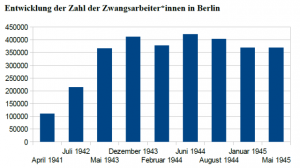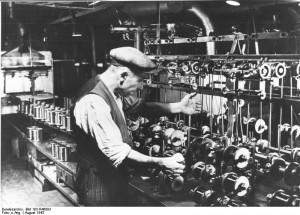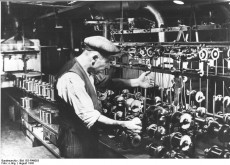Forced Labor in Berlin and Brandenburg
Deutsch
Berlin was the center for forced labor and armaments production in the Nazi German Reich. The forced labor that took place at Tempelhof Airport represents one of the many ways in which the Nazis implemented forced labor both in the Reich capital city and the surrounding areas
Extent of Forced Labor in Berlin
“At that time Berlin was overrun with wooden barracks. Rows of brown, tar-covered buildings made of spruce crowded into every empty space available in the enormous city. Greater Berlin constituted a single compound, crammed in between the solid structures, the memorials, the office buildings, the train stations, the factories,” recalled the French writer and former forced laborer François Cavanna in his description of the capital of the Reich.a
In fact, all of the administrative districts of Berlin were covered by a network of approximately 3,000 forced labor camps. There was a camp around almost every corner, and especially high concentrations were to be found near the various locations of the defense industry.
At the turn of the year 1942/43, most of the civilian forced laborers worked and lived in Reinickendorf (20,461), Spandau (18,722) and Tempelhof (15,652). Tempelhof stood out due to its particularly high concentration of workers within a relatively small amount of square kilometers. The Weserflug Camp at Tempelhof Airport housed 1,700 forced laborers, and at the time it was the sixth biggest camp in Berlin.
In addition to foreign civil workers, prisoners of war from Stalag III D (a prisoner of war, or “POW,” camp) in Berlin, as well as Jewish Berliners and concentration camp prisoners, were utilized. The following graph shows the rate of growth of forced laborers in Berlin from April 1941 to May 1945. In addition, the chart also shows the presence and increase of Eastern workers and the systematic forced recruitment of laborers which began in 1942. Due to air raids and the subsequent relocation of industry, the number of laborers in the winter of 1943/44 decreased. Please note that the numbers for 1945 are based on estimations.

Expansion of the Use of Forced Laborers in Berlin. Source: Bräutigam, Helmut: Zwangsarbeit in Berlin 1938-1945. In: Arbeitskreis Berliner Regionalmuseen (Hg.): Zwangsarbeit in Berlin 1938-1945. Berlin 2003. S. 30.
Albert Speer’s Role as General Building Inspector and Minister of Armaments
Before the beginning of the war, General Construction Inspector (Generalbauinspektor, or GBI) Albert Speer advocated for the Berlin redevelopment project. He wanted to transform Berlin into the “World Capital of Germania” and put thousands of foreign laborers to work in order to see this project completed. In the spring of 1939, laborers arrived in Berlin from the occupied part of Czechoslovakia. Beginning in 1938, as part of a “closed work detail,” Jewish Berliners were isolated from the other workers and forced to carry out physically difficult labor without any training, primarily in the construction industry.
In order to centralize the deployment of forced labor, Speer was also named the Minister of Armaments in the spring of 1942. As a result of his promotion, he became responsible for the central areas of Berlin, as well as the Armaments Ministry’s camp building program. After Siemens (a German engineering and electrical firm) and the Reichsbahn (the German State Railway), Speer was the largest operator of forced labor camps in the greater Berlin area from 1942 to 1943.
Forced Labor in the Berlin Armaments Industry
The armaments industry in Berlin was compromised of some of the most modern manufacturing plants of the time, especially for the development of electro-technology, airplane motors and tanks. Only a limited number of foreign workers were initially put to work in the munitions plants due to concerns about the threat of espionage. It was not until 1941 that one could speak of a mass organized implementation of foreign workers in the Berlin armaments industry. There were reservations when it came to the utilization of Czechs and Poles in restricted manufacturing production areas. Therefore, the majority of workers at the beginning of the war were “Western workers.” Overall, the percentage of foreign workers in Berlin was significantly less than those working in other German cities. By the end of April 1941, 4.6% of the workers in Berlin were from abroad, while the average in the entire Reich was closer to 11%.

Pictured above is a Belgian worker who was forcibly taken from his home and made to work as a winder (someone who operates the bobbin) at the Siemens factory in Berlin, where enameled wires were manufactured. This photo, from August of 1943, was taken by order of Siemens and thus cannot be considered representative of actual working conditions in the factory.
Source: Bundesarchiv, Bild 183-R46093 / CC-BY-SA, http://en.wikipedia.org/wiki/File:Bundesarchiv_Bild_183-R46093,_Belgischer_Zwangsarbeiter_bei_Siemens.jpg
Since the end of 1940, most Jewish Berliners had been forced to work in “closed work details” in the armaments industry; around 230 Berlin companies had established so-called “Jewish sections.” Despite their importance to the war effort, Jewish forced laborers were arrested and deported to Auschwitz on February 27th and 28th, 1943 as part of the Factory Action (Fabrikaktion). The goal of the Factory Action was to replace the Jewish forced laborers with Polish forced laborers who had been forced to leave their homes in order to make room for Germans to settle the area. The annihilation of the Jews was directly connected with this goal, specifically propagated by Hitler, to “conquer new space (Lebensraum) in the East.”.
As a direct result of the war, it became increasingly difficult to deport foreign workers to Germany, and furthermore, demand for forced laborers was beginning to increase among the various branches of industry in Berlin and Brandenburg. In order to fulfill the need for workers, forced laborers who worked in agriculture were transferred from the fields into the factories during the winter months. In 1940, for example, 30,000 prisoners of war were brought from Stalag III A in Luckenwalde to Berlin for Speer’s construction projects.
Forced Labor in the Brandenburg Agricultural Industry
In 1939, following the beginning of the war, Polish POWs (later known as civil workers, or Zivilarbeiter), were deported to work in the agricultural industry in Brandenburg. Unfortunately, only a limited number of sources pertaining to forced labor in the agricultural industry are in existence today. One thing is certain – the forced laborers who worked in the fields were not supervised as strictly as those who worked in the cities.
In July 1943 an anonymous report was sent to the district president of Potsdam concerning the violation of the night-time curfew by Polish forced laborers. “Instead of going to their sleeping quarters at 9pm, they wander around half the night! And then when they have to work the next day, they’re tired and act in an insolent manner.” The person who wrote this report held local farmers responsible for the situation because the farmers apparently maintained “that Polish people are humans too.”b Polish forced laborers were subjected to discrimination under the rules and regulations of the Polish Decree, enacted in March 1940. Following the enforcement of the Eastern Workers Decree, or Ostarbeiter Erlasse, in February 1942, forced laborers from the Soviet Union began to suffer similar sorts of discrimination.
KZ - Concentration camp
KZ Außenlager - Satellite camp
GBI - General Construction Inspector (Generalbauinspektor)
Rüstungsministerium - Ministry of Armaments
AEL - Labor rehabilitation camp (Arbeitserziehungslager)
Stalag - Prisoner of war camp
“Labor Rehabilitation Camps” as Disciplinary Measure
So-called “labor rehabilitation camps” (Arbeitserziehungslager, or AEL) served as forms of discipline for Germans criminals, but especially for the foreign labor force in both industry and agriculture. Forced laborers could be sent to an AEL for various acts of defiance such as arriving late to work, taking sick days and working slowly, as well as escape attempts.
The living conditions in the AEL were similar to those in concentration camps, with the key difference being that the length of imprisonment varied from between twenty-one days to three months. The aim of the limitation was to make the imprisoned workers quickly available for manufacturers again. In Berlin and Brandenburg, some of the AEL camps were located in Fehrbellin, where the female prisoners were put to work by the Bastfaser GmbH company (focused on processing fibers for the textile industry), and some in the Wuhlheide district, where the male prisoners had to work for AEG (a German electrical engineering and industrial design company).
“Extermination through work” – Forced Labor in External Concentration Camps
The Gestapo-run AELs are in some cases regarded as precursors to the satellite camps run by the SS (although there is a lack of sources for this area of research). The SS satellite camps were primarily set up after Joseph Goebbels’ (Reichsminister of Propaganda) proclamation of Total War in 1943. The failure of the SS to develop their own “imperial economy” put the existing economy under significant pressure, which made it possible for Speer to loan concentration camp prisoners to the defense industry. The two sizable concentration camps in Brandenburg, Sachsenhausen and Ravensbrück, had a number of satellite camps and external command stations (Außenkommandos) in and around Berlin.
History of Forced Labor: Complications of Research
A central problem with researching forced labor is the insufficient amount of employment and/or labor records, as well as suspected inaccuracies in the existing records. Many workers do not appear in the maintained records because their work was not regarded as efficient and mostly consisted of menial work and/or unskilled labor.
Through the 1990s, most of the companies involved with force labor defended their involvement using the “Werkzeugtheorie”. This theory, translated into English as the “Tool and/or Instrument Theory,” supposes that these companies only utilized forced laborers under duress from the Nazi authorities, and were therefore passive participants in the forced labor industry. However, new research has determined that many companies simply requisitioned forced laborers both to increase their earnings and to fulfill requirements and contracts determined by the regime.
Written by Melanie Huchler
Translated by Alissa Rubinstein and Courtney Neaveill
References
- Arbeitskreis Berliner Regionalmuseen (Hg.): Zwangsarbeit in Berlin 1938-1945. Berlin 2003.
- Berliner Geschichtswerkstatt e.V. (Hg.): Kein Ort der Freiheit – Das Tempelhofer Feld 1933- 1945. Berlin 2012.
- Mai, Uwe: Kriegsgefangen in Brandenburg. Stalag III A in Luckenwalde 1939-1945. Berlin 1999.
- Meyer, Winfried/Neitmann, Klaus (Hg.): Zwangsarbeit während der NS-Zeit in Berlin und Brandenburg. Formen, Funktion und Rezeption. Potsdam 2001.
Additional Links
- Search for Traces: A Worker’s Pay Slip (German only)
- Berliner Geschichtswerkstatt (Hg.): Arbeitserziehungslager Fehrbellin. Zwangsarbeiterinnen im Straflager der Gestapo. Potsdam 2004. http://www.politische-bildung-brandenburg.de/publikationen/pdf/fehrbellin.pdf (German only)
- Pagenstecher, Cord: Lagerlisten und Erinnerungsberichte. Neue Quellen zur Topografie und ärztlichen Betreuung der Berliner Zwangsarbeiterlager. http://www.cord-pagenstecher.de/pagenstecher-2004a-lagerlisten.pdf (German only)
- Stiftung Topography of Terror, Nazi Forced Labor Documentation Center: http://www.dz-ns-zwangsarbeit.de/en/
Notes
- 1. Cavanna, François: Das Lied der Baba (orig. Les Russkoffs). Berlin 1988. Quoted according to Pagenstecher, Cord: Lagerlisten und Erinnerungsberichte. Neue Quellen zur Topografie und ärztlichen Betreuung der Berliner Zwangsarbeiterlager. http://www.cord-pagenstecher.de/pagenstecher-2004a-lagerlisten.pdf S. 6. [06.04.2013] (back)
- Quoted according to Schmidt, Frank: „Der Ausländereinsatz in der brandenburgischen Landwirtschaft – Reglementierung der Lebensverhältnisse“. In: Meyer, Winfried/Neitmann, Klaus (Hg.): Zwangsarbeit während der NS-Zeit in Berlin und Brandenburg. Formen, Funktion und Rezeption. Potsdam 2001. S. 69 (back)
